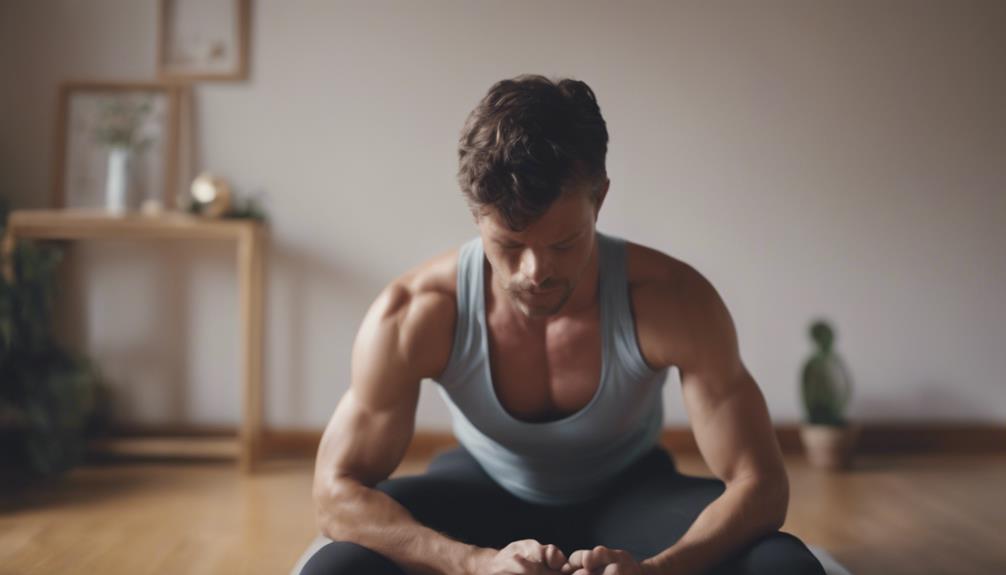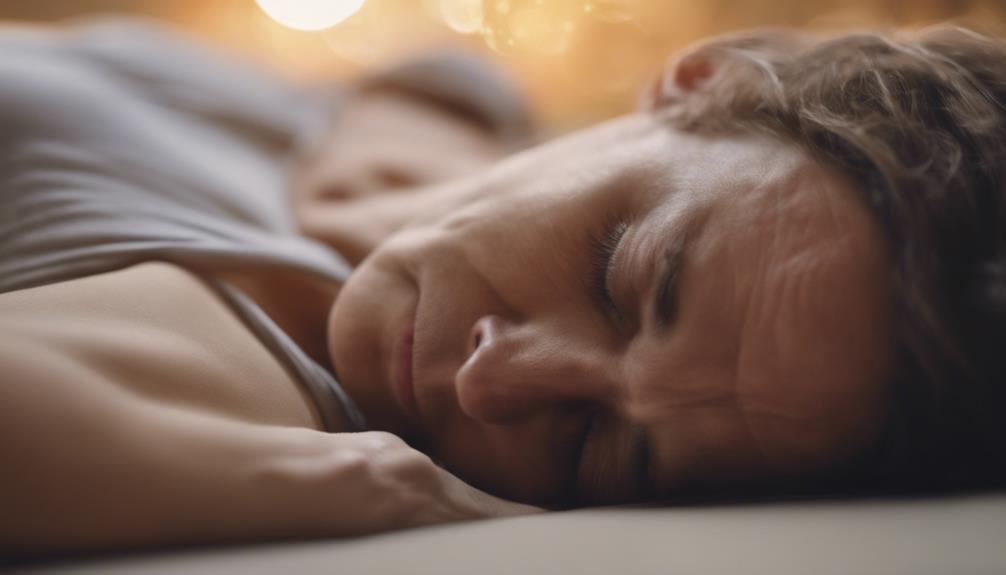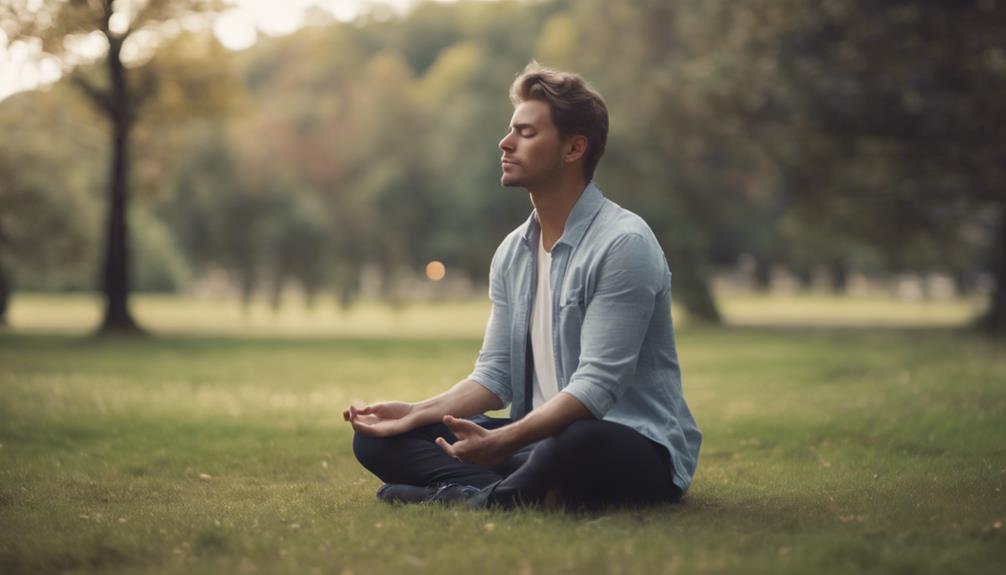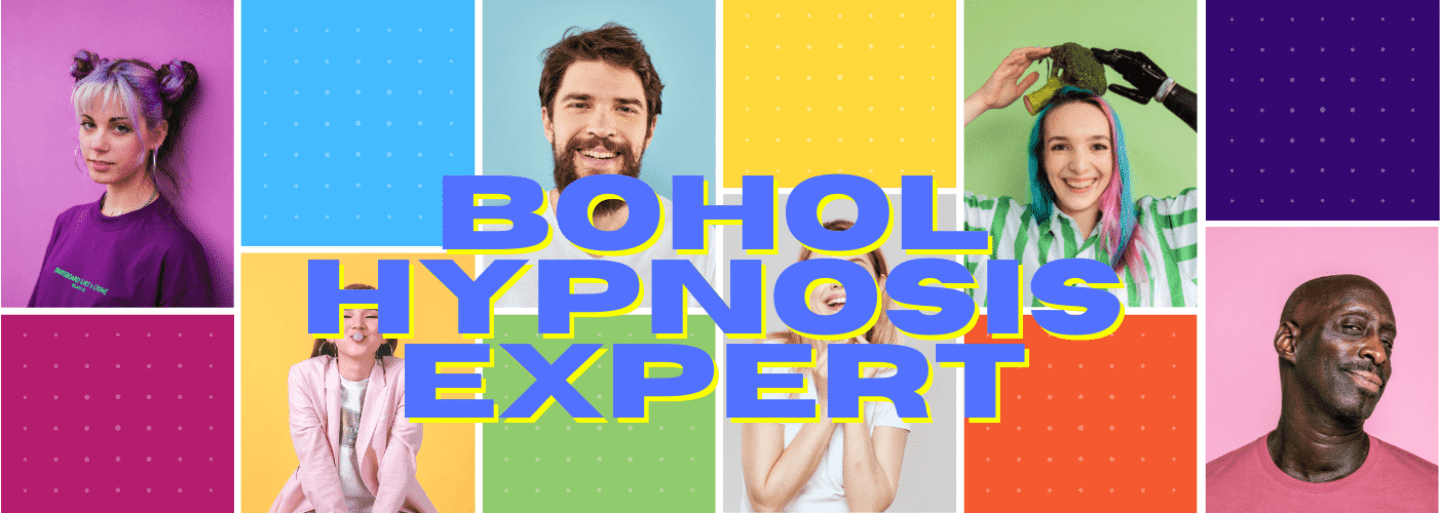
Overcoming anxiety with self-hypnosis involves powerful techniques like deep breathing, progressive muscle relaxation, and visualization. These methods help alleviate stress, reframe negative thoughts, and enhance emotional regulation for effective anxiety management. By fostering relaxation and mental reprogramming, self-hypnosis empowers individuals to combat anxiety triggers and promote overall well-being. Additionally, techniques such as body awareness and stress management through hypnosis offer valuable tools for coping with anxiety effectively. Discover how self-hypnosis techniques can provide a holistic approach to reducing anxiety and enhancing emotional stability.
Key Takeaways
- Deep breathing activates relaxation response, reduces anxiety symptoms, and enhances well-being.
- Progressive muscle relaxation alleviates stress, promotes body relaxation, and enhances emotional regulation.
- Visualization promotes relaxation, reduces anxiety levels, and rewires the brain for positive responses.
- Body awareness in self-hypnosis facilitates relaxation, increases mindfulness, and improves stress management.
- Calming visualization, affirmations, breathing exercises, emotional regulation, and stress management aid in overcoming anxiety.
Benefits of Self-Hypnosis for Anxiety
Self-Hypnosis for anxiety offers a powerful tool for individuals seeking relief from overwhelming feelings of stress and worry by fostering relaxation and mental reprogramming. It serves as a valuable technique for those struggling with anxiety disorders, providing a means to reframe negative thought patterns and desensitize oneself to anxiety triggers. By incorporating positive suggestions and hypnotic techniques, self-hypnosis can effectively reduce symptoms associated with anxiety.
One of the key benefits of self-hypnosis for anxiety is its emphasis on stress management and coping strategies. Through regular practice, individuals can learn to enter a state of deep relaxation, enabling them to better manage their emotions and responses to stressors. By engaging in self-hypnosis techniques, individuals can cultivate a sense of inner calmness and develop the ability to counteract anxious thoughts with more positive and empowering beliefs.
Studies have shown that the practice of self-hypnosis can lead to significant improvements in managing anxiety over the long term. By integrating self-hypnosis into their daily routine, individuals can enhance their emotional resilience and build a foundation for lasting mental well-being. Ultimately, self-hypnosis serves as a valuable tool for individuals looking to take control of their anxiety and cultivate a greater sense of peace and balance in their lives.
Deep Breathing Technique for Anxiety
In exploring techniques to alleviate anxiety, one effective approach is the deep breathing technique. This method involves taking slow, deep breaths to activate the body's relaxation response, which can markedly reduce symptoms of anxiety. Deep breathing promotes better oxygen flow, calms the nervous system, and effectively lowers heart rate and blood pressure during moments of heightened anxiety. Research studies have shown that incorporating deep breathing into daily routines can not only improve focus and lower stress levels but also enhance overall well-being.
Regular practice of deep breathing can help individuals manage anxiety and even prevent panic attacks. By integrating deep breathing into daily life, individuals can experience a powerful yet simple self-hypnosis technique that promotes relaxation and calmness. The deep breathing technique serves as a valuable tool in the arsenal against anxiety, offering a natural and accessible way to combat its symptoms.
Incorporating deep breathing into daily routines can have a profound impact on mental well-being. By prioritizing moments of deep breathing, individuals can tap into a sense of inner peace and tranquility, ultimately leading to a more balanced and centered state of mind.
Progressive Muscle Relaxation for Anxiety

Progressive Muscle Relaxation is a powerful technique that involves systematically tensing and releasing muscle groups to alleviate anxiety and stress.
By engaging in this practice, individuals can activate the relaxation response in their bodies, promoting a sense of calm and well-being.
Muscle tension release through PMR can be a valuable tool in managing anxiety symptoms and fostering a deeper mind-body connection.
Muscle Tension Release
Muscle tension release through the technique of Progressive Muscle Relaxation is a powerful method for alleviating anxiety and promoting relaxation in the body. By systematically tensing and relaxing muscle groups, this self-hypnosis technique helps reduce anxiety, release physical tension, and facilitate stress reduction.
Progressive Muscle Relaxation enables individuals to gain better control over their physical responses to anxiety by increasing awareness of muscle tension. This practice can be easily incorporated into daily routines, offering a convenient way to manage anxiety from the comfort of home.
Research indicates that regular use of Progressive Muscle Relaxation can lead to decreased anxiety levels and an overall improvement in well-being. Embracing this method may provide individuals with a valuable tool for enhancing relaxation and coping with stress.
Relaxation Response Activation
Activation of the relaxation response through systematic muscle tension release is a highly effective method for managing anxiety and promoting overall well-being. Progressive Muscle Relaxation (PMR), a self-hypnosis technique, facilitates deep relaxation by alternating between tensing and relaxing muscle groups. This process not only alleviates anxiety but also enhances emotional regulation.
By engaging in PMR, individuals can reduce muscle tension, leading to a marked decrease in anxiety levels and a calming effect on both the body and mind. Research indicates that regular practice of PMR can notably lower anxiety levels, improve sleep quality, and boost overall wellness.
Accessible and easily learned through guided instructions or audio recordings, incorporating PMR into daily routines empowers individuals to effectively manage anxiety symptoms, enhance relaxation responses, and foster better emotional well-being.
Visualization for Anxiety Relief
In the domain of self-hypnosis techniques for anxiety, visualization emerges as an essential tool for promoting relaxation and emotional control. By envisioning calming scenes like a tranquil beach or a peaceful forest during self-hypnosis sessions, individuals can effectively reduce their anxiety levels. This technique allows for a mental escape from stressors, providing a sense of relief and empowerment over anxious thoughts. Research indicates that visualizing positive outcomes and scenarios can actually rewire the brain, enabling individuals to respond more positively to triggers of anxiety.
Detailed imagery plays an important role in enhancing the effectiveness of self-hypnosis for anxiety relief and emotional regulation. When individuals immerse themselves in vivid visualizations, they deepen their mind-body connection, fostering better management of anxiety and overall well-being. Regular practice of visualization not only serves as a coping mechanism but also strengthens the ability to control emotional responses to stressors.
Incorporating visualization into self-hypnosis routines offers a holistic approach to anxiety management, empowering individuals to cultivate a sense of calm and resilience. By harnessing the power of the mind's eye, individuals can navigate through anxious moments with greater ease and composure, paving the way for improved mental health and emotional well-being.
Body Awareness in Self-Hypnosis

Engaging in self-hypnosis involves cultivating a heightened awareness of one's physical being to facilitate relaxation and alleviate anxiety symptoms. Body awareness in self-hypnosis revolves around honing in on physical sensations and reactions to promote a state of calmness and reduce anxiety levels effectively. By focusing on the body, individuals can connect with themselves on a deeper level, identifying areas of tension or stress. Through the utilization of breathing techniques and visualization exercises, these individuals can release this tension, fostering a sense of relaxation and control over their anxiety.
Practicing body awareness during self-hypnosis sessions not only aids in managing stress but also enhances mindfulness and self-regulation. This approach enables individuals to address anxiety triggers by tuning into their bodily cues, thereby increasing self-awareness. By incorporating body awareness into self-hypnosis routines, individuals can achieve a profound state of relaxation, leading to improved stress management, emotional balance, and overall well-being. This fosters a strong mind-body connection, allowing individuals to better understand and respond to the signals their body is sending, ultimately assisting in the alleviation of anxiety symptoms.
Positive Hypnotic Suggestions for Anxiety
When facing anxiety, incorporating positive hypnotic suggestions can be a powerful tool in promoting inner peace and resilience.
By focusing on calming visualization techniques, affirmations for relaxation, and breathing exercises for calmness, individuals can cultivate a sense of control over their anxious thoughts and feelings.
These tailored suggestions serve to reframe negative patterns, fostering a more positive and empowered mindset to navigate through moments of distress.
Calming Visualization Techniques
Utilizing calming visualization techniques combined with positive hypnotic suggestions forms a powerful strategy for alleviating anxiety and promoting a sense of inner peace.
- Visualization techniques: Imagining calming scenes like a peaceful beach or serene forest can reduce anxiety levels effectively.
- Positive suggestions: Incorporating affirmations such as 'I am calm and in control' during visualizations helps reframe anxious thoughts.
- Sensory imagery: Detailed sensory experiences like feeling the warmth of the sun or hearing gentle waves enhance the relaxation response in self-hypnosis.
- Inner peace: Visualizing a safe, comforting place triggers a relaxation response, reducing physical tension and fostering inner peace.
Affirmations for Relaxation
Building on the foundation of calming visualization techniques, incorporating affirmations for relaxation in self-hypnosis serves as a vital tool for cultivating inner peace and combating anxiety. Affirmations like 'I am calm and at peace' or 'I breathe in relaxation and breathe out tension' can reprogram the subconscious mind to reduce anxiety levels.
Positive hypnotic suggestions such as 'I am in control of my thoughts and emotions' play an essential role in managing anxiety triggers effectively. By utilizing affirmations for relaxation in self-hypnosis, individuals can promote a sense of inner peace and emotional stability amidst anxiety-provoking situations.
Clinical Hypnosis and self-hypnosis techniques offer a holistic approach to making positive changes and reducing anxiety through the power of affirmations.
Breathing Exercises for Calmness
Incorporating deep breathing exercises into self-hypnosis practices can greatly enhance the cultivation of calmness and relaxation for individuals seeking relief from anxiety. Utilizing controlled breathing techniques can effectively reduce stress and anxiety levels by triggering the body's relaxation response.
When combined with positive hypnotic suggestions, breathing exercises become even more powerful in promoting a sense of tranquility and peace. Focusing on slow, deep breaths can lead to a decrease in heart rate, lower blood pressure, and instill a feeling of serenity.
Through regular practice of breathing exercises with positive suggestions, individuals can retrain their minds to respond calmly to anxiety triggers, fostering a greater sense of emotional well-being.
Improving Emotional Regulation Through Hypnosis
Enhancing emotional regulation through hypnosis involves delving into the subconscious triggers and responses that underlie anxiety, paving the way for effective coping strategies and emotional resilience. By utilizing techniques such as reframing negative thoughts and creating positive affirmations, individuals can enhance their ability to manage emotions in anxiety-inducing situations. Through hypnosis, individuals can reprogram automatic reactions to stressors, allowing for more adaptive responses.
Hypnosis offers a unique opportunity to access the subconscious mind, where deep-seated beliefs and responses reside. In this relaxed state, individuals can learn new ways of responding to anxiety triggers, fostering a sense of calm and rationality. By teaching individuals effective coping strategies, hypnosis equips them with the tools needed to navigate challenging emotions with greater ease.
The process of improving emotional regulation through hypnosis is a journey of self-discovery and empowerment. It enables individuals to gain a deeper understanding of their emotional patterns and triggers, leading to increased emotional resilience. By actively engaging with the subconscious mind, individuals can learn to manage their emotions in a more conscious and intentional manner, ultimately enhancing their overall well-being.
Self-Hypnosis for Stress Management

Utilizing self-hypnosis techniques for stress management empowers individuals to cultivate a state of deep relaxation and mental clarity conducive to reducing anxiety and enhancing emotional well-being.
Here are four key components of self-hypnosis for stress management:
- Progressive Muscle Relaxation: Self-hypnosis involves techniques like progressive muscle relaxation, where individuals systematically tense and release muscle groups to induce a state of physical relaxation, which can help alleviate stress and anxiety.
- Positive Affirmations: By incorporating positive affirmations during self-hypnosis sessions, individuals can reframe negative thoughts and beliefs, promoting a more optimistic outlook and reducing anxiety levels.
- Visualizations: Visualizing calming and peaceful scenes during self-hypnosis can help individuals create a mental sanctuary to retreat to in times of stress, fostering a sense of inner calmness and tranquility.
- Emotional Regulation and Coping Skills: Regular practice of self-hypnosis can lead to improved emotional regulation and coping skills, equipping individuals with effective tools to manage stressors and maintain a balanced emotional state.
Overcoming Negative Thought Patterns
Challenging ingrained negative thought patterns through self-hypnosis techniques can empower individuals to cultivate a more thorough and resilient mindset in overcoming anxiety. By incorporating positive affirmations and visualizations into self-hypnosis practices, individuals can gradually reframe their perspectives and foster empowering beliefs. Visualizing themselves in calm and serene environments or repeating affirmations that instill confidence and peace can help counteract the impact of negative thoughts on anxiety levels.
Furthermore, relaxation techniques integrated into self-hypnosis, such as deep breathing exercises and progressive muscle relaxation, serve as valuable tools in combating anxious thoughts. These practices not only promote a sense of calmness during self-hypnosis sessions but also help individuals manage stress and anxiety more effectively in their daily lives. Additionally, utilizing self-suggestions and guided imagery within self-hypnosis sessions can create a mental landscape conducive to reducing anxiety levels. By guiding their minds towards positive outcomes and reinforcing adaptive coping mechanisms, individuals can gradually diminish the grip of negative thought patterns on their well-being.
In essence, self-hypnosis techniques offer a thorough approach to addressing negative thought patterns associated with anxiety, providing individuals with the tools to foster a more optimistic and resilient mindset. Regular practice and dedication to these techniques can significantly contribute to managing and overcoming anxiety in a holistic manner.
Developing Coping Strategies for Anxiety

As individuals navigate the challenges of anxiety, it becomes essential to cultivate effective coping strategies that can provide comfort and relief.
Breathing techniques offer a simple yet powerful way to calm the mind and body, fostering a sense of control amidst anxious moments.
Additionally, visualization exercises can serve as a potent tool in reshaping negative thought patterns and promoting a more peaceful mindset.
Breathing Techniques for Anxiety
Deep breathing techniques are valuable tools that can effectively manage anxiety by activating the body's relaxation response. Employing controlled breathing patterns can reduce stress hormones and induce a sense of calm during anxious moments.
Techniques like diaphragmatic breathing, box breathing, and 4-7-8 breathing have shown efficacy in managing anxiety levels by enhancing oxygen flow, lowering heart rate, and improving focus. Consistent practice of these breathing exercises can retrain the body's response to stress, leading to an overall enhancement in well-being.
Visualization Exercises for Anxiety
Utilizing visualization exercises is a powerful strategy for developing coping mechanisms to manage anxiety effectively. By creating mental images of peaceful settings or scenarios, individuals can reduce anxiety and lower stress levels.
Research indicates that visualization techniques can greatly improve emotional well-being by helping individuals imagine themselves successfully coping with anxiety triggers or picturing a safe, serene place. Incorporating visualization into self-hypnosis practices can train the mind to respond positively to anxiety-inducing situations, ultimately strengthening one's mindset.
Regular practice of visualization not only enhances the mind-body connection but also empowers individuals to better manage their anxiety, promoting a sense of calm and resilience in the face of stressors.
Frequently Asked Questions
How Do I Hypnotize Myself for Anxiety?
When hypnotizing yourself for anxiety, utilize deep breathing, visualization techniques, progressive relaxation, positive affirmations, mindful meditation, guided imagery, autogenic training, and self-hypnosis scripts.
These methods can help induce a state of calmness and reframe negative thoughts. By incorporating these techniques into your routine, you can effectively manage anxiety symptoms and promote emotional well-being.
Regular practice is key to harnessing the benefits of self-hypnosis for anxiety relief.
What Is the 3-3-3 Rule for Anxiety?
The 3-3-3 rule for anxiety involves acknowledging three things, sensing three things, and acting on three things to ground oneself in the present moment. It aids in reducing anxiety by redirecting focus away from worries and promoting mindfulness.
This technique encourages individuals to engage their senses and take immediate actions to effectively manage anxiety symptoms. By practicing the 3-3-3 rule, individuals can break the cycle of anxious thoughts and regain control over their emotions.
Can Hypnosis Stop Anxiety?
Hypnosis can indeed be a powerful tool in alleviating anxiety.
By engaging in breathing exercises, positive affirmations, visualization techniques, progressive relaxation, mindful meditation, mental imagery, guided imagery, and self-suggestion techniques, individuals can effectively manage and reduce anxiety levels.
These techniques help reframe negative thought patterns and induce a state of relaxation, ultimately aiding in overcoming anxiety.
Hypnosis offers a holistic approach to addressing anxiety and promoting emotional well-being.
What Is the Success Rate of Hypnosis for Anxiety?
The success rate of hypnosis for anxiety is notable, with studies showing effectiveness rates of up to 93%.
Utilizing a combination of meditation techniques, breathing exercises, visualization methods, progressive muscle relaxation, positive affirmations, mindfulness practices, guided imagery, and cognitive restructuring can enhance the outcomes of hypnotherapy.
These techniques, when integrated into hypnosis sessions, contribute to reducing anxiety levels and improving overall well-being for individuals seeking relief from anxiety disorders.
Conclusion
To sum up, self-hypnosis techniques offer a powerful tool in managing anxiety by promoting relaxation, emotional regulation, and coping strategies.
By incorporating deep breathing, progressive muscle relaxation, visualization, and body awareness, individuals can overcome negative thought patterns and develop effective stress management skills.
Through the practice of self-hypnosis, individuals can find inner peace and strength to navigate the challenges of anxiety, leading to a more balanced and fulfilling life.





